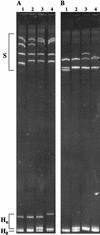Assessment of hepatitis C virus sequence complexity by electrophoretic mobilities of both single-and double-stranded DNAs
- PMID: 9738054
- PMCID: PMC105098
- DOI: 10.1128/JCM.36.10.2982-2989.1998
Assessment of hepatitis C virus sequence complexity by electrophoretic mobilities of both single-and double-stranded DNAs
Abstract
To assess genetic variation in hepatitis C virus (HCV) sequences accurately, we optimized a method for identifying distinct viral clones without determining the nucleotide sequence of each clone. Twelve serum samples were obtained from seven individuals soon after they acquired HCV during a prospective study, and a 452-bp fragment from the E2 region was amplified by reverse transcriptase PCR and cloned. Thirty-three cloned cDNAs representing each specimen were assessed by a method that combined heteroduplex analysis (HDA) and a single-stranded conformational polymorphism (SSCP) method to determine the number of clonotypes (electrophoretically indistinguishable cloned cDNAs) as a measure of genetic complexity (this combined method is referred to herein as the HDA+SSCP method). We calculated Shannon entropy, incorporating the number and distribution of clonotypes into a single quantifier of complexity. These measures were evaluated for their correlation with nucleotide sequence diversity. Blinded analysis revealed that the sensitivity (ability to detect variants) and specificity (avoidance of false detection) of the HDA+SSCP method were very high. The genetic distance (mean +/- standard deviation) between indistinguishable cloned cDNAs (intraclonotype diversity) was 0.6% +/- 0.9%, and 98.7% of cDNAs differed by <2%, while the mean distance between cloned cDNAs with different patterns was 4.0% +/- 3.2%. The sensitivity of the HDA+SSCP method compared favorably with either HDA or the SSCP method alone, which resulted in intraclonotype diversities of 1.6% +/- 1.8% and 3.5% +/- 3.4%, respectively. The number of clonotypes correlated strongly with genetic diversity (R2, 0.93), but this correlation fell off sharply when fewer clones were assessed. This HDA+SSCP method accurately reflected nucleotide sequence diversity among a large number of viral cDNA clones, which should enhance analyses to determine the effects of viral diversity on HCV-associated disease. If sequence diversity becomes recognized as an important parameter for staging or monitoring of HCV infection, this method should be practical enough for use in laboratories that perform nucleic acid testing.
Figures




References
-
- Axton R A, Hanson I M, Love J, Seawright A, Prosser J, van Heyningen V. Combined SSCP/heteroduplex analysis in the screening for PAX6 mutations. Mol Cell Probes. 1997;11:287–292. - PubMed
-
- Bukh J, Miller R H, Purcell R H. Genetic heterogeneity of hepatitis C virus: quasispecies and genotypes. Semin Liver Dis. 1995;15:41–63. - PubMed
-
- Calvo P L, Kansopon J, Sra K, Quan S, Dinello R, Guaschino R, Calabrese G, Danielle F, Brunetto M R, Bonino F, Massaro L, Polito A, Houghton M, Weiner A J. Hepatitis C virus heteroduplex tracking assay for genotype determination reveals diverging genotype 2 isolates in Italian hemodialysis patients. J Clin Microbiol. 1998;36:227–233. - PMC - PubMed
-
- Carrington M, Millter T, White M, Gerrard B, Stewart C, Dean M, Mann D. Typing of HLA-DQA1 and DQB1 using DNA single-stranded conformational polymorphism. Hum Immun. 1992;33:208–212. - PubMed
Publication types
MeSH terms
Substances
Associated data
- Actions
- Actions
- Actions
- Actions
- Actions
- Actions
- Actions
- Actions
- Actions
- Actions
- Actions
- Actions
- Actions
- Actions
- Actions
- Actions
- Actions
- Actions
- Actions
- Actions
- Actions
- Actions
- Actions
- Actions
- Actions
- Actions
- Actions
- Actions
- Actions
- Actions
Grants and funding
LinkOut - more resources
Full Text Sources
Molecular Biology Databases

